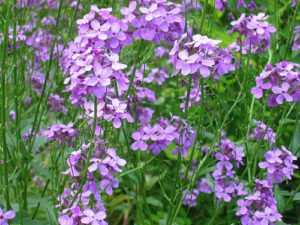Written by Julia Adams, summer education intern
Summer is a great time to see many beautiful, colorful plants and flowers beginning to grow. It’s always refreshing to see the bright colors after the dreary winter passes. Seeing the bright purple color of the flowers on the dame’s rocket plants lately, was a great reminder that spring and summer were finally here. Little did I know, dame’s rocket is an invasive species that I would soon help to remove from the Woodland Dunes Nature Preserve.

dame’s rocket
The first day I was removing dame’s rocket with some fellow interns, I saw only a few and thought that there was not much of a problem, or, the other workers and volunteers from the preserve were very good at removing it. After picking for a little while, I noticed through some trees where there were more. As I walked closer, the area was not as small as I had originally thought. There were spots in the preserve that were almost completely covered in dame’s rocket. That’s when I knew this was an important problem to solve.
Invasive species are non-native that can harm the environment. Dame’s rocket grows very rapidly and grows tall enough to block the sun from getting to native species. Because of this, the native species can’t get enough sunlight and eventually end up being overtaken by the dame’s rocket. Since these species are native, it is important to keep them in the preserve to help native wildlife that may use these plants. Dame’s rocket makes this more difficult to achieve.
Dame’s rocket is very easy to identify. It is part of the mustard family and came to the U.S. in the 1600s. It was planted and used as an ornamental species. However, because of it’s high seed production, it quickly escaped cultivation and grew in the wild. Dame’s rocket thrives in areas such as prairies, roadsides, ditches, open woodlands, and other disturbed areas. The plant can grow up to four feet tall and has leaves that alternate – going up and down the fuzzy, rough stem. At the top of the plant there are flowers that have four petals that make a cross. The flowers can be purple, pink, and white and usually bloom in the late spring. The first year of growth tends to be just foliage, and in the second year, the flowers start to bloom.
When you encounter dame’s rocket, it can commonly be confused with phlox, which also has purple flowers but has five petals instead of four. Once properly identified, dame’s rocket can easily be removed by pulling out the root by hand, if the soil is soft, or by digging the root out with a small spade. Because it is an invasive species, dame’s rocket is not to be purchased or planted in Wisconsin. Although the flowers are beautiful and the colors are pretty, this invasive species can harm the environment and ecosystems around us and should be removed when possible.
